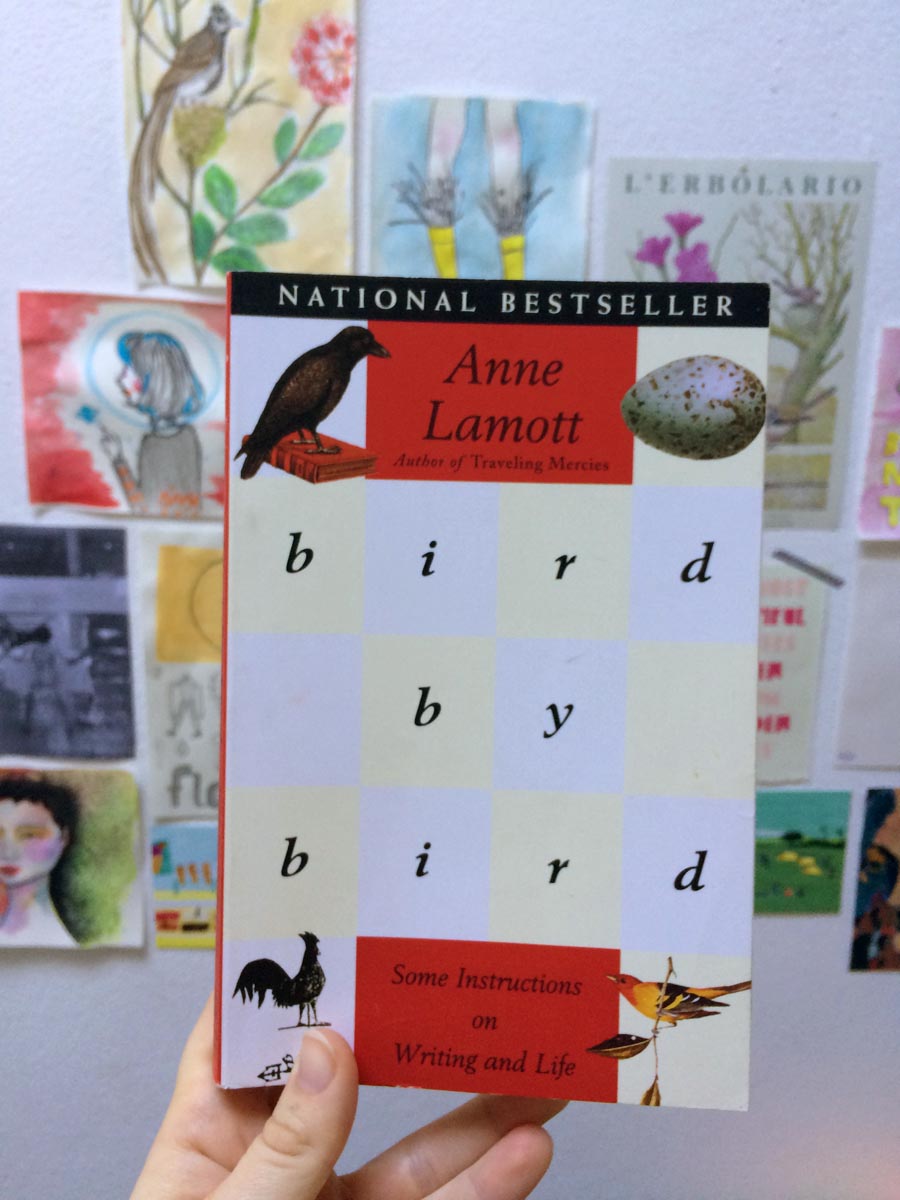
Bird by Bird: Some Instructions on Writing and Life by Anne Lamott es uno de los libros más conocidos sobre el arte de escribir que encontré, así que obviamente tenía que averiguar de qué se trataba.
Las ideas principales que me quiero guardar en mis bolsillos y llevar a todos lados:
Porqué escribimos:
We write to expose the unexposed. If there is one door in tthe castle you have been told not to go through, you must. Most human beings are dedicated to keeping that one door shut. But the writer’s job is to see what’s behind it.
Cuándo te preguntás para qué escribis, recordá el efecto que tiene la escritura sobre las personas que se topan con ella:
What your giving can do is help your readers be braver, be better than they are, be open in the world again.
Lo que implica la escritura:
So much of writing is about sitting down and doing it every day, and so much is about getting into the custom of taking in everything that comes along.
Lo que exige la escritura:
Everything we need in order to tell our stories in a reasonable and exciting way already exists in each of us. Everything you need is in your head and memories, in all that your senses provide, in all that you’ve seen and thought and absorbed.
El miedo más grande:
Be afraid of not getting your writing done.
La obligación moral de la escritura y como lo particular se vuelve universal:
If something inside you is real, we will probably find it interesting, and it will probably be universal. So you must risk placing real emotion at the center of your work. Write straight into the emotional center of things. Write toward vulnerability. Don’t worry about being sentimental. Worry about being unavailable; worry about being absent or fraudulent. Risk being unliked. Tell the truth as you understand it. If you are a writer, you have a moral obligation to do this.
¿Y qué es la verdad?
It turns out that the truth, or reality, is our home.
¿Cómo acceder a esa verdad?
You can’t get to any of these truths by sitting in a field smiling beatifically, avoiding your anger and damage and grief. Your anger and damage and grief are the way of the truth.
La disciplina que libera:
This feeling is something my students report, especially those in writing groups, this feeling of liberation that, ironically, discipline brings.
Si querés escribir sobre tu pasado o situaciones traumáticas, hacelo:
Use these memories, I told them. They are yours. This should not have happened to you.
La relación indestructible que existe entre la escritura y la conciencia:
To participate [in writing] requires self-discipline and trust and courage, because this business of becoming conscious, of being a writer, is ultimately about asking yourself: How alive am I willing to be?
Becoming a writer is about becoming conscious. (Lo mismo que dijo Cheryl Strayed: “That’s the writer’s work: it’s consciousness.”)
Porqué es necesario exponerse al escribir:
’Why though?’ my students ask, staring at me intently. ‘Why are we supposed to open all these doors? Why are we supposed to tell the truth in our own voice?’ And I stare back at them for a moment. I guess because it’s our nature, I say. And the truth of your experience can only come through your own voice. You cannot write out of someone else’s big dark place; you can only write out of your own.
Dani Shapiro también responde a la pregunta sobre la exposición necesaria de cualquier artista.
Escribir es solo una de las tantas formas de dar:
You are going to have to give and give and give, or there’s no reason for you to be writing. You have to give from the deepest part of yourself, and you are going to have to on giving, and the giving is going to have to be its own reward.
Un consejo muy útil que me causó gracia:
Write as if your parents are dead.
La anécdota más tierna y emotiva del libro:
Here is the best true story on giving I know, and it was told by Jack Kornfield of the Spirit Rock Meditation Center in Woodacre. An eight-year-old boy had a younger sister who was dying of leukemia, and he was told that without a blood transfusion she would die. His parents explained to him that his blood was probably compatible with hers, and if so, he could be the blood donor. They asked him if they could test his blood. He said sure. So they did and it was a good match. Then they asked if he would give his sister a pint of blood, that it could be her only chance of living. He said he would have to think about it overnight.
The next day he went to his parents and said he was willing to donate the blood. So they took him to the hospital where he was put on a gurney beside his six-year-old sister. Both of them were hooked up to IVs. A nurse withdrew a pint of blood from the boy, which was then put in the girl’s IV. The boy lay on his gurney in silence while the blood dripped into his sister; until the doctor came over to see how he was doing. Then the boy opened his eyes and asked, ‘How soon until I start to die?’
Si te gustó este post, suscribite al blog para recibir novedades en tu mail. También podés seguirnos en Instagram (donde compartimos cosas del día a día) y en Facebook. Para conocer más qué nos inspira, seguinos en Tumblr.
¿Querés aparecer en PAC? Estamos buscando ilustradores, fotógrafos y personas que hagan imágenes visuales para que acompañen nuestros artículos. Si estás interesado o conocés a alguien que tenga un estilo similar al nuestro, ¡avisanos!